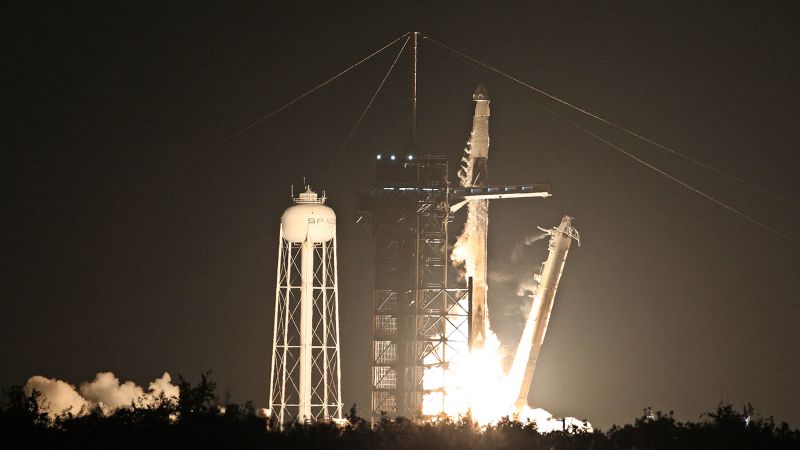On a momentous Monday evening, SpaceX unveiled the launch of its innovative Fram2 mission. This endeavor, characterized as a significant milestone in commercial space travel, saw a Crew Dragon spacecraft embark on an extraordinary journey, propelled by a Falcon 9 rocket from NASA’s Kennedy Space Center located in Florida. The mission is distinguished by its unique trajectory, which orbits directly over both the North and South poles—an unprecedented achievement in human spaceflight.
The centerpiece of the Fram2 mission is Chun Wang, a resident of Malta who amassed his wealth through ventures in Bitcoin mining. Wang footed the bill for this extraordinary expedition, although the exact amount remains undisclosed. Accompanying him on this path to the cosmos are an eclectic group of polar exploration enthusiasts: Jannicke Mikkelsen, a Norwegian film director; Rabea Rogge, a robotics researcher based in Germany; and Eric Philips, an Australian adventurer. All four crew members are embarking on their first journey to space, sharing a passion for polar exploration that underscores the mission’s ethos.
The Falcon 9 rocket, which launched at approximately 9:46 PM ET, initiated its flight by heading southward. This unconventional path required the rocket to traverse territories that no human spaceflight mission had previously navigated. As the crew capsule moved through the atmosphere, it was destined to soar over numerous countries, including Cuba and Panama, enabling a captivating excursion around the globe.
A few moments post-launch, the Falcon 9’s first-stage booster disengaged, successfully making its own descent onto a maritime platform. Meanwhile, the rocket’s upper stage accelerated the spacecraft, rapidly achieving orbital speeds exceeding 17,500 miles per hour (28,000 kilometers per hour) to position the astronauts for their adventure over Earth’s polar regions.
During the flight, the crew planned to execute 22 research experiments focusing on crew health, the outcomes of which would enhance our understanding of human physiology in space. While some skeptics argue that the polar orbit may deviate from purely scientific pursuits, it embodies a visually and experientially striking element of this private mission.
Director Mikkelsen articulated the uniqueness of their expedition by emphasizing that they are no typical NASA astronauts, noting, “We’ve gone from nothing to being certified astronauts to fly.” This sentiment encapsulates the journey from Earth to the cosmic frontier, illustrating the increasing accessibility of space travel.
Interestingly, successful launches aimed at achieving an orbital path around the poles from locations like Florida are rare. Conventional launches usually utilize the Earth’s rotation to maximize performance when heading eastward. The Fram2 mission, with its trajectory built on ambitious polar exploration, required substantial power expenditure. Dr. Craig Kluever, a mechanical and aerospace engineering professor at the University of Missouri, pointed out that such a flight path may lead to considerable losses in performance but ultimately did not hinder Falcon 9’s capabilities.
The different aspects of this mission also extend into the financial domain. While it’s unclear how much Wang invested in the Fram2 journey, he is a prominent figure in the blockchain sector, co-founding F2Pool, a leading Bitcoin mining organization responsible for approximately 11% of the cryptocurrency’s global computational output. Despite his wealth being estimated in the billions, Wang’s profile remains relatively low among cryptocurrency influencers.
The Fram2 crew’s passion for polar regions was evident throughout their training, which included rigorous preparations in Alaska, mirroring the extreme conditions they’ll face in space. With backgrounds ranging from adventurers like Philips, who boasts roughly 30 excursions to polar regions, to Mikkelsen’s cinematic ventures in environmental storytelling, the team has cultivated a unique narrative surrounding their mission.
As the Fram2 mission progressed, the public eagerly observed this unprecedented journey. Although it garnered mixed sentiments regarding its nature, the mission heralded a fresh era in space tourism, showcasing the collaborative efforts of scientists, entrepreneurs, and adventurers in their quest to explore the universe beyond our planet. Wang, upon expressing his exhilaration, noted, “Everything that needs to be done is done. From here on, it’s just following the procedures.” His sentiments signaled not only personal eagerness but also the burgeoning excitement surrounding private space exploration in the years to come.












